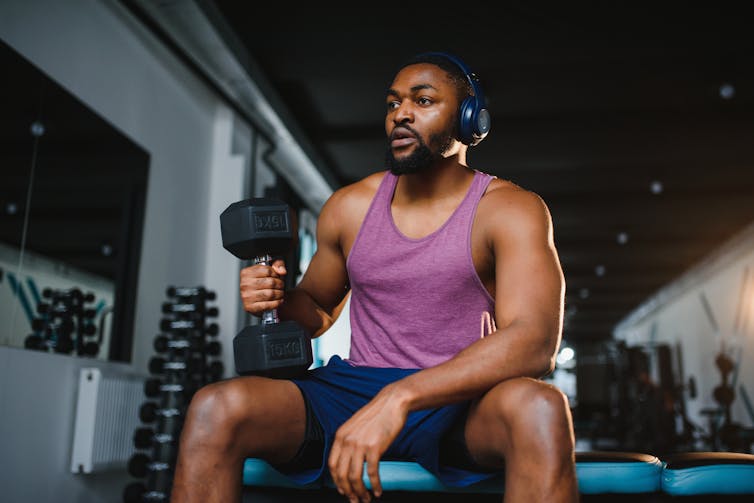After recovering from COVID, you might be eager to get out and do some exercise, particularly if you’d previously enjoyed keeping fit. While a bit of light cardiovascular training can be a good option, strength training has some particular advantages when it comes to getting over COVID.
You can listen to more articles from The Conversation, narrated by Noa, here.
When our immune system mobilises to fight a COVID infection, this response, called inflammation, can take a toll on various parts of the body, including the muscles. So regaining muscle strength is one benefit of strength training after COVID.
We also know COVID can affect our energy levels and capacity to perform aerobic exercise. Research suggests that during rehabilitation for respiratory problems, strength training – performed either alone or alongside cardio – improves our ability to carry out activities of daily living requiring sustained breathing (functional capacity).
Similarly, a recent review of exercise programmes specifically for COVID patients after hospital discharge showed that strength training alongside a small amount of moderate-intensity cardio was linked to improvements in functional capacity and quality of life, such as through reduced stress.

This article is part of Quarter Life, a series about issues affecting those of us in our twenties and thirties. From the challenges of beginning a career and taking care of our mental health, to the excitement of starting a family, adopting a pet or just making friends as an adult. The articles in this series explore the questions and bring answers as we navigate this turbulent period of life.
You may be interested in:
Stroke: young people can have them too – here’s how to know if you’re at risk and what to look out for
75 Hard: what you need to know before taking on this viral fitness challenge
Five reasons why young people should get a COVID booster vaccine
If you’ve only just recovered from COVID, it’s important to take things slowly. Knowing exactly when to return to exercise depends on several factors, including the type and severity of your symptoms.
People who had heart or lung-related symptoms such as myocarditis (inflammation of the heart muscle), an irregular heartbeat or severe difficulty breathing, during or after COVID, should talk with a doctor before exercising again.
Those still experiencing severe body aches, sore throat, shortness of breath, chest pain, general fatigue, cough or fever should avoid exercises for two to three weeks after these symptoms have resolved.
Guidance for athletes with minimal or no symptoms has ranged from continuing to exercise during the infection to waiting 14 days after any symptoms subside. However, as most of us aren’t professional athletes, it may be wiser to err on the side of caution.
Read more:
Regaining fitness after COVID infection can be hard. Here are 5 things to keep in mind before you start exercising again
Due to the stress COVID places on multiple systems of our body, particularly our cardio-respiratory system, controlling the demand on our heart and lungs is crucial when deciding how to exercise after infection.
One advantage of strength training over cardio is that it doesn’t require the same level of oxygen consumption. This means we’re not forced to breathe increasingly harder and faster when doing it.
We can also change multiple aspects of a strength training programme to reduce our body’s need for oxygen. Increased duration of exercise, shorter rest periods between sets, faster repetitions and higher numbers of repetitions all increase our need for oxygen. So training with fewer repetitions and more rest between sets may be a good idea to start off with.
Exercises to try
Many strength-training programmes involve dedicated training days for specific muscles such as the back, chest or legs. Over a week this approach may result in too much overall work when recovering from COVID.
The good news is that compound exercises can work multiple muscles simultaneously – and some research suggests there’s no additional benefit in including single-joint exercises in a workout.
Examples of compound exercises include push-ups, squats, rows, pull-ups, deadlifts, shoulder press, bench press and dips.
The authors of a study I mentioned earlier suggest that training for post-COVID patients could comprise one to two sets of eight to ten repetitions at 30%–80% of the 1RM (the maximum weight you can usually perform one repetition of the exercise with), alongside five to 30 minutes of moderate cardio.

Hryshchyshen Serhii/Shutterstock
When you’re ready to increase the intensity of your strength training, if using weights, increase the weight first rather than the number of sets or repetitions. If you’re doing bodyweight exercises, try adding an extra set rather than more repetitions (to still allow yourself regular rest periods), or consider using equipment like resistance bands to increase the challenge.
Listen to your body
Although you may be tempted to start where you left off, evidence suggests a gradual return to pre-infection activity levels may be best.
While people recovering from a serious infection should consult with their doctor, those returning from a mild to moderate infection are advised to start at about 50% of the intensity of their pre-COVID training regime.
When you do return to training, or if you don’t normally do strength training but are trying it as part of your COVID recovery, watch out for if you start to feel very tired. It’s essential to listen to your body and adjust your workouts based on how well your body copes with them.
Read more:
Weekend warrior workouts: here’s how to make the most of them
If your workouts feel manageable, you could try the 50/30/20/10 approach which strength and conditioning coaches use to help athletes return to training after an extended period of inactivity.
So start by reducing your overall training volume (the combined total of sets, repetitions and weight) by 50% compared to what you did before catching COVID. The week after, progress to 30% less, then 20%, then 10%. If your body tolerates the training well, at the end of these four weeks, you’ll be back to completing the same routine you were doing pre-infection.
However, it’s important to remember that progress isn’t linear. You may be able to increase the volume each week, but you may also need time to build up more gradually.
![]()
Jack McNamara does not work for, consult, own shares in or receive funding from any company or organisation that would benefit from this article, and has disclosed no relevant affiliations beyond their academic appointment.











